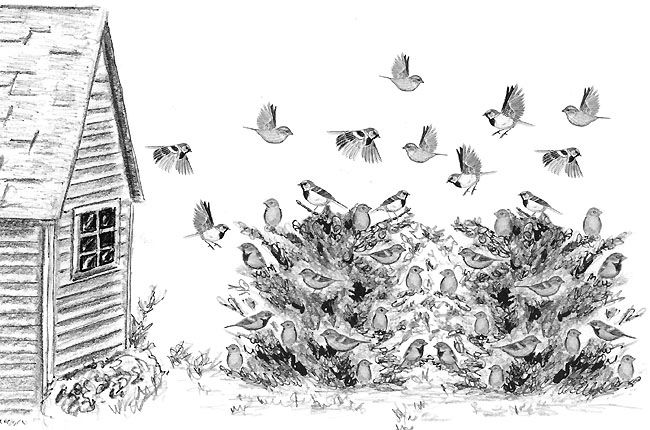
Dear Bird Folks,
I live in an apartment above a restaurant, where there are lots of finches living in the eves and the hedges down below. Every evening the finches become all excited, take off and fly around in circles for no apparent reason. Do you think these are young birds trying out their wings or could it be a sign a storm is coming?
– Sandy, Sandwich, MA
Finally, Sandy,
When I first started writing this column, back in the ‘40s, I thought it would be cute to answer questions from people with alliterative names. I envisioned getting questions from Harry in Hyannis, Charlie in Chatham, Frank in Falmouth and Wishbone in Wellfleet. But none of that ever happened. In fact, the only Wishbone whoever wrote to me was from Brewster and what good was that? That’s why I’m thrilled, after all these years, to get a question from you, Sandy in Sandwich. I’ve been waiting for you all my life…well, at least since the ‘40s.
Now that I’ve said all those nice things, I feel a little bad about having to correct you, but not bad enough not to do it. I’m pretty sure the “finches” of which you speak aren’t finches at all, but are most likely sparrows. A House Finch couple will often nest under a deck, or on a porch light or even in a hanging plant, but a pair of House Finches is not “lots, of finches.” Lots for birds flying in and out of eves and hedges, sounds more like House Sparrows to me. House Sparrows and House Finches have a lot in common, so it’s easy to confuse the two. For example, both birds have the same first name, they both like to live near people and like many of us, neither one is native to this area. House Sparrows were imported from England, while the House Finch was imported from California, which explains why they’re always whistling Beach Boys’ tunes.
The female House Finch and House Sparrow look rather similar. Both are plain brown birds, but no one should mix up the males. Male House Finches have a red head and chest, and red on the base of the tail. Male House Sparrows are mostly a blend of gray and chestnut-brown. They also wear a distinguishing black bib on their chests, which scientists claim is related to their social status, but I think they wear the bibs because they’re messy eaters. If you see one House Finch you are likely see to five or six, but if you see a House Sparrow you’ll probably see fifty or sixty of them. House Sparrows love each other’s company, and they also love restaurants.
My store is totally surrounded by eateries and as a result, the area is loaded with House Sparrows. The bushes, trees and parking lot are alive with sparrows and there’s no doubt that the scraps from the nearby restaurants have a lot to do with it. (Well, that and the 400 tons of birdseed we sell each year.) House Sparrows are found throughout the country, and the world, but they are especially common in cities, where they fit in perfectly. Sparrows dig cities because they have something in common with many city people: they totally have type A personalities. A pair of Mourning Doves can sit for hours and just watch the world go by. But House Sparrows are like Alice’s White Rabbit; they are in constant motion, appearing to be late for everything, even though they have no place to go.
During the day sparrows search the local area for food. They aren’t fussy eaters and will eat everything from insects, to weed seeds and, of course, restaurant food. You might think that after a hard day of foraging the birds would be tired, but sunset is their least favorite time of day. It means they have to finally settle down and they hate that. Like kids being forced by their parents to go to bed, House Sparrows don’t go quietly. Instead of simply finding a quiet place to tuck its head under its wing (actually, its back feathers), a sparrow will get together with twenty or thirty of its buddies and head off to a communal roosting area. But like everything sparrows do, it’s not that simple and it’s always full of energy.
Towards the end of the day House Sparrows move to a “pre-roosting” site, which actually may be several sites. The energetic birds fly from one thicket to the next, creating tons of noise as they go. Why so much noise? It is thought all the commotion and flying about alerts the neighboring sparrows that it’s time to come to the roost, but they act like sleeping is the last thing they have on their minds.
Eventually, the birds move on to the prime roosting site, but even there they have trouble calming down. The entire roost sounds as if it is going to explode with chirps and squabbling. Researchers believe all the noise inside the roost is a form of communication that helps the birds gain important information from each other. But if they’re anything like my family, they are really arguing over who gets the perch closest to the bathroom.
I think the excited sparrows (aka, finches) you see flying around each evening aren’t necessarily young birds and they certainly aren’t predicting the weather. They are simply getting ready for bed. And believe it or not, at some point they actually calm down and finally go to sleep. Thanks for the question, Sandy from Sandwich. Your name and your hometown are just the combination I’ve been looking for. Now if I can only get a question from Dennis from Dennis, I can die a happy man.